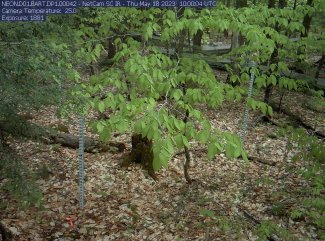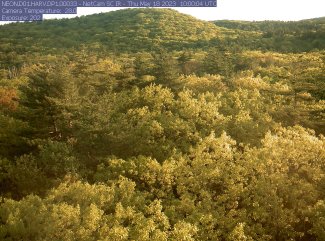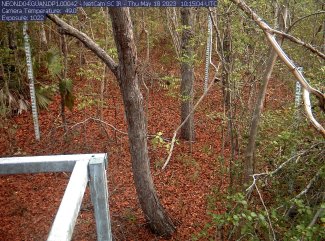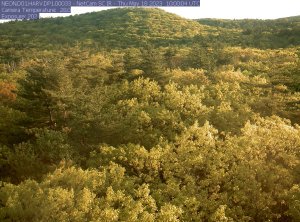What Makes a Forest? Forested Field Sites Across the Observatory
May 18, 2023
oFrom the conifers of the northern boreal forest to the ʻōhiʻa groves of Hawai'i, there are many different types of forests represented among the NEON field sites. Many of our aquatic sites also run through riparian forests. Altogether, these sites showcase the diversity of forests across the North American continent.
Seeing the Forest for the Trees
There are almost as many definitions for the term "forest" as there are types of forests. The Food and Agriculture Organization (FAO) of the United Nations defines a forest as: "Land spanning more than 0.5 hectares with trees higher than 5 meters and a canopy cover of more than 10 percent, or trees able to reach these thresholds in situ." From an ecological perspective, a forest is a biotic community dominated by trees and containing a complex, interconnected web of plant, animal, microbial, and fungal species. Forests play a crucial role in supporting biodiversity, maintaining the global carbon balance, and providing essential resources such as wood, food, and clean water.
Forest composition, structure, and other characteristics vary widely across regions and more locally depending on elevation, topography, soil conditions, land use and management history, and interrelationships among plant and animal species. Some forests have dense understories that are home to an incredibly wide variety of organisms. Others are dominated by a few species and have a more open structure. Old-growth forests (those that have gone a very long time without significant disturbance events like fires) can look dramatically different than younger, second-growth forests.
The NEON field sites include examples of many different types of forests, representing common or iconic forest types for each zone. These are some examples of the forests you will find across the Observatory.
The Boreal Forest (Taiga)
The boreal forest, or Taiga, is one of the largest biomes on Earth, spanning the northern latitudes across Alaska, Canada, Siberia, and Scandinavia. Boreal forests make up about 30% of the total forested areas globally and play an important role in carbon sequestration. These forests are characterized by:
- A forest canopy dominated by evergreen conifers such as spruce, fir, and pine.
- Cold with long, cool winters with temperatures (often far) below freezing and a short growing season.
- Low to moderate precipitation, with much precipitation coming in the form of snow.
- Relatively low biodiversity, with plant and animal species adapted to cold conditions.
The Taiga Domain (D19) for the NEON program is made up primarily of spruce boreal forests interspersed with birch, poplar, aspen, and other deciduous trees and shrubs. All three D19 terrestrial field sites (Delta Junction, Healy, and Caribou Creek) are mostly or partially forested.

The spruce forest at Delta Junction is typical of the boreal forest biome in Alaska.
The Temperate Rainforest
The Pacific Northwest (D16) is home to several types of forest but is known for its stunning temperate coniferous rainforests. These forests are characterized by high levels of precipitation, a relatively mild climate, and dense vegetation. The coastal areas of Washington and Oregon are home to temperate rainforests dominated by tall coniferous trees such as Douglas fir, western hemlock, Sitka spruce, and western red cedar. The forested NEON field sites at Wind River Experimental Forest and Abby Road are both excellent examples.

Abby Road is managed by the Washington Department of Natural Resources as a working forest for timber production and recreation.

Wind River has been home to silviculture studies and forest research since 1909. It contains old-growth stands that are more than 450 years old.
Further south, coniferous temperate forests of the Sierra Nevada Range, in the Pacific Southwest (D17), feature species such as lodgepole pine, Jeffry pine, ponderosa pine, cedar, and red and white fir. This region is also home to the stunning giant sequoia forests, found on the western slopes of the Sierra Nevada range in Central California. Coniferous forests in many parts of the Pacific Southwest have been heavily impacted by drought, wildfire, and beetle activity.

Soaproot Saddle has experienced significant tree mortality, with loss of much of its traditional ponderosa pine overstory in many areas.
Alpine Forests
Alpine forests are found at high elevations, above the montane forests and below the alpine tundra. Similar to the boreal forests of the Taiga and the northern temperate rainforests, alpine forests in the northern Rockies are composed primarily of coniferous species, which can include a mix of spruce, pine, and fir. Species at these high elevations must be able to withstand harsh alpine conditions, which may include extreme cold and heavy snow in the winter months. Our Yellowstone National Park site spans more than 400 meters of elevation, with pine-dominated forest at the upper elevations and sage and grasslands lower down.

The Upper Yellowstone sampling area features lodgepole pine and Douglas fir.
Temperate Deciduous and Mixed Forests
Much of the eastern U.S. is characterized by temperate deciduous and mixed forests. These forests can have significant variation by region as well as locally within regions, with specific forest characteristics heavily impacted by local temperatures, topography, and soil type. Most temperate deciduous and mixed forests boast high levels of biodiversity, with some of the most diverse areas in the U.S. found in the forests of the Appalachians, Ozark Plateau, and the coastal plains of the eastern U.S. Many eastern deciduous and mixed forests feature a dense understory of shrubs and herbaceous vegetation.
The hardwood forests of the Northeast Domain (D01) are comprised of sugar maple, American beech, and yellow birch. In contrast, mixed forests may include broadleaf deciduous trees such as oak, hickory, maple, beech, and birch along with coniferous species like pine, hemlock, and spruce. Bartlett Experimental Forest and Harvard Forest both feature eastern deciduous and mixed forest types.

The forest understory at BART. Bartlett Experimental Forest contains a mix of old-growth and secondary-growth forested areas, dominated by hardwoods such as beech and sugar maple interspersed with white pine at lower elevations.

Harvard Forest is a second-growth forest featuring red oak, red maple, and white pine with a rich understory.
Oak-hickory and oak-pine forests are common in the Mid-Atlantic region (D02), transitioning to bottomland hardwood forests and bald cypress further south. All three D02 field sites (Smithsonian Conservation Biology Institute, Smithsonian Environmental Research Center, and Blandy Experimental Farm) are partially or mostly forested.

Blandy Experimental Farm includes portions of Casey Tree Farm, a tree nursery. The surrounding areas features a deciduous forest with black oak, tulip poplar, and pawpaw.

SCBI is dominated by deciduous hardwood forest featuring oak, hickory, ash, and tulip poplar.
The Great Lakes (D05), Appalachian and Cumberland Plateau (D07), and Ozarks Complex (D08) also feature temperate hardwood and mixed forests with a wide variety of species mixtures.

Great Smoky Mountains National Park contains one of the largest remaining stands of old-growth deciduous forest in the eastern U.S. and is renowned for its biodiversity.
Southeastern Longleaf Pine Forests
The longleaf pine forests are unique ecosystems found in the southeastern United States (D03, Southeast). Historically, these forests covered a vast area stretching from Virginia to eastern Texas and parts of Florida, encompassing approximately 90 million acres. However, due to logging, agriculture, and urbanization, the longleaf pine ecosystem has been reduced to roughly 3% of its original range, making it one of the most endangered ecosystems in North America. The Jones Center at Ichauway and Ordway-Swisher Biological Station both feature longleaf pine ecosystems that provide important habitat for species such as the endangered red cockaded woodpecker.

A longleaf pine and oak ecosystem at JERC.

At OSBS, longleaf and lobolly pine and turkey oak are interspersed with a wiregrass and forb groundcover.
Subtropical Dry Forest
Guanica Dry Forest, located in Puerto Rico in the Atlantic Neotropical Domain (D04), is a stunning example of a rare forest type; it is the largest remaining dry tropical coastal forest in the world. While rainforests are more common in subtropical and tropical zones, this dry forest is characterized by a warm climate and low rainfall (~840 mm annually). Vegetation is thick and dense, with more than 700 plant species represented. The forest is divided into three main areas: an upland deciduous forest, a semi-evergreen forest, and a scrub forest near the shore.

The warm forest floor at Guanica Dry Forest.
Tropical Rainforest
On the far side of Observatory, in the middle of the Pacific Ocean, the Pu'u Maka'ala Natural Area Reserve (NAR) is a tropical rainforest ecosystem. Located in the Pacific Tropical Domain (D20), the NAR features wet 'ōhi'a and koa forests with a dense fern understory. It is one of the most ecologically diverse places in the world, home to many endemic species found nowhere else on Earth.

The forest floor at PUUM, featuring large hapu‘u tree ferns.
Riparian Forests
Riparian forests are found along the banks of rivers, streams, and other water bodies. These forests are characterized by the presence of water-loving plant species and are shaped by the interactions between the terrestrial and aquatic environments. Riparian forests play crucial roles in maintaining water quality, stabilizing streambanks, providing habitat for diverse plant and animal species, and supporting overall watershed health. Many of the NEON aquatic sites have riparian forests along their sampling reaches.

A mixed-oak riparian forest at Pringle Creek, in the Southern Plains (D11).

Walker Branch, in the Appalachians and Cumberland Plateau (D07), is surrounded by a dense hardwood forest dominated by oaks and hickories.

Kings Creek, in the Prairie Peninsula (D06), is shaded by a deciduous gallery forest of bur oak, chinquapin oak, walnut, elm, hackberry, and hickory, extending five to one hundred meters from the stream channel.
The wide and varying forests represented in the NEON repertoire are each stunning and essential in their own ways. Many researchers have used NEON's standardized data to inform their studies and publish papers that could help land managers better understand the importance of these ecosystems and how they may be changing.

